Istanbul: My return after 30 years finds a beautiful, troubled city but the shopping is good
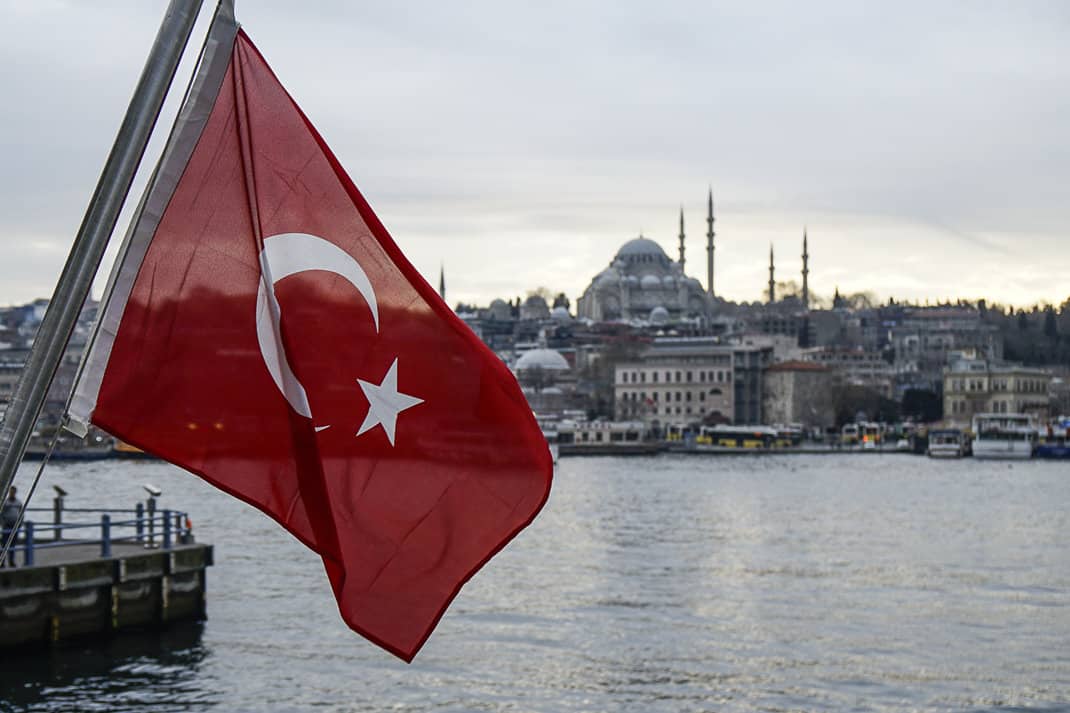
(Director’s note: This is the first of a four-part series on Istanbul. Today: Istanbul 30 years later.)
“If the Earth were a single state, Istanbul would be its capital.” – Napoleon Bonaparte
ISTANBUL – Empires rise. Empires fall. I know. I live in Rome. The most powerful civilization in history has been reduced to a minor player on the world stage. Rome is all fluff and little clout, a showgirl long past her glory days.
I spent four days in Istanbul last week and had the same vibe. Only in Istanbul it’s worse. The city has cleaned itself up to a glossy shine but it doesn’t hide the massive societal stain hidden under all the pretty baubles shining on the city’s hills.
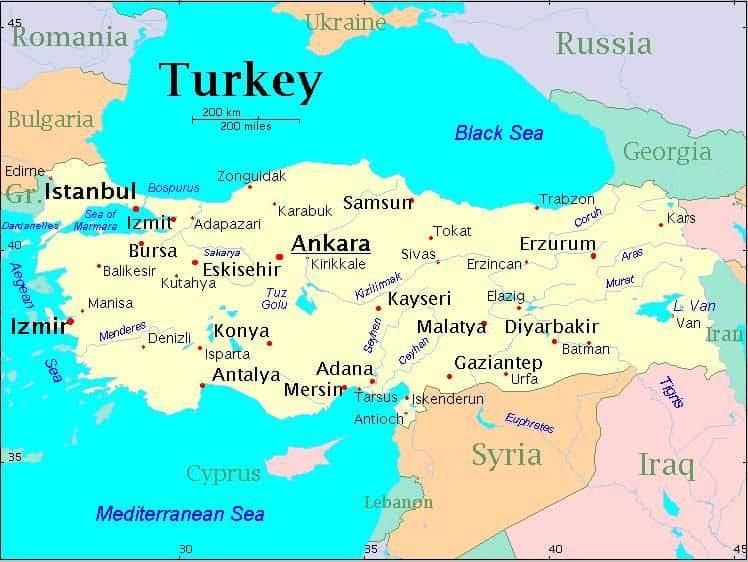
When Napoleon ran roughshod around Europe in the early 1800s, Istanbul was known as Constantinople. Its powerful Ottoman Empire stretched from Azerbaijan to the Danube to North Africa. Today’s Turkey is teetering on the edge of collapse, with a cratering economy, a deadly earthquake it hasn’t cleaned up and a hated, demonic president hanging on by his dirty fingernails.
It is here where I celebrated my birthday Wednesday.
Why Istanbul?
Technically, I came to celebrate Marina’s birthday. She wanted to return to Istanbul for her first time since 1990; I hadn’t been here since ‘93. We always take each other someplace for our birthday and my choice was Cyprus. However, Cyprus’ beaches are much better around Marina’s birthday June 14; Istanbul is less hot in March. So we flipped destinations.

What I found was a city I didn’t recognize. The happy, jovial Turks from the early ‘90s are sad, worried and angry. I spent four days with Turks whispering their frustration in my ear.
But boy, the city is even more beautiful than I remembered.
It started with our arrival. Ataturk Airport, the dark, dingy den of gloom where Billy Hayes was busted for smuggling hashish in “Midnight Express,” closed in 2019 after 107 years. In its place is the shiny $7 billion Istanbul Airport, now one of the five busiest in Europe.
We flew into Sabiha Gokcen International, itself built in 2001.
As someone who takes pride in quickly mastering a city’s public transportation, I insisted we take Istanbul’s modern Metro subway into the city. After a 15-minute walk down an empty corridor, we came across a machine for the Istanbulkart, the indispensable card you need to use all of the city’s transport options.
I couldn’t get it to work. I couldn’t understand what I was buying. It wouldn’t take my credit card. It wouldn’t take my cash. The cops who busted Billy Hayes were more cooperative, and I was madder than Billy Hayes. (More on him in a later blog.) It was no small consolation that other tourists looked at the machine like you would the inside of a jet engine.

I reluctantly gave all 800 lira (about €40) I had just taken from the cash machine to a cabbie for a ride to our Artefes Hotel in Sultanahmet, the heart of Istanbul’s historical district. We dumped our bags and went across the street for our traditional arrival beer that Marina hoped would keep me from nuking the airport.
Marbella restaurant became our home away from home. It’s a pretty three-level seafood restaurant with an enclosed back veranda overlooking the Marmara Sea. It’s the perfect spot for Turkey’s signature Efes beer while watching tugboats steam past tankers and seagulls whirling overhead.
Bosphorus cruise
Not far from the hotel, the Strait of Bosphorus is one of the most important bodies of water in the world. It separates Europe and Asia with Istanbul spanning both continents. I remembered 30 years ago dining at romantic restaurants – alone, unfortunately – along the water, joining happy Turks toasting with raki, Turkey’s licorice-flavored whisky so strong its navy also uses it as boat fuel. Today the restaurants have been replaced by stuffy nightclubs with bad food and attitudes to match.
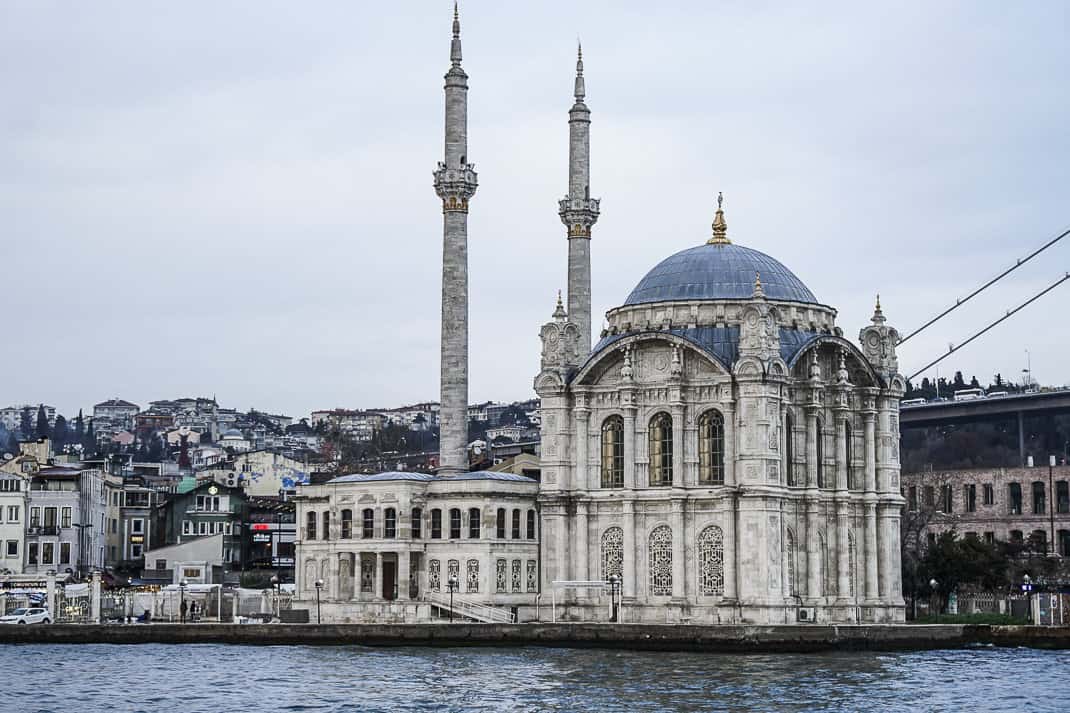
Yet the Bosphorus itself is worth exploring. We took a three-hour Bosphorus cruise that truly illuminated Istanbul as we’ve never seen it, from its spectacular beauty to its brilliant architecture to its jaw-dropping size.
We cruised for an hour and we still saw huge, modern apartment houses and office buildings. When I visited in 1993, Istanbul had 7.2 million people. Today it has 17 million. The Syrian crisis moved 4 million refugees into the city. More than 3.5 million refugees overall are in Turkey seeing international protection.

I went to the tour guide, pointed to all the buildings going by and asked, “Are these suburbs?” He looked at me curiously like I asked if Muslims pray.
“No. It’s still Istanbul,” he said.
Besides the call to prayer, which happens five times a day, there’s no better way to feel the power of Islam than on a Bosphorus cruise. Istanbul has 3,300 mosques. Near the port, we could see the beautiful 16th century Suleymaniye Mosque, all snow white with turquoise domes and 10 balconies.

Atop another hill was legendary and controversial Aya Sofya, lit up in bright gold light. It began as a church in 537. Ottoman sultan Mehmet the Conqueror turned it into a mosque in 1453. The Ottomans were murderous thugs and rapists but they were also pretty good architects.

In 1935 Aya Sofya became a museum under benevolent Mustafa Ataturk, the forward-thinking father of modern Turkey. Then president Recap Erdogan turned it back into a mosque in 2020 as part of his turn-back-the-clock-two-centuries Islamic plan.
Atop another hill we saw Istanbul’s latest landmark. The $110 million Grand Camlica Mosque, designed by two Turkish women, was built in 2019 and can hold 63,000 worshippers and has 70 domes with the main dome reaching 72 meters in height. This mosque has more domes than any Christian church I know has doors.

Grand Bazaar
I remember walking into the Grand Bazaar in 1993 and wondering if I entered the world’s largest opium den. Back then it was dark and foreboding. Wires and cables hung loosely from the ceiling. Old shopkeepers sat on little stools sipping thick coffee in dodgy glasses. Poorly lit and crowded, its narrow hallways zigzagged endlessly like a North African medina.
I walked into the Grand Bazaar Thursday and thought I’d entered a shopping mall in Dallas. The place was lit up like Yankee Stadium. The ceilings had bright white paint with artistic designs. You could eat off the tile floors. We stopped for coffee in a tony cafe, featuring an olive tree in the middle with soft jazz playing on a loudspeaker. It could’ve been in the Montmartre in Paris.
A shopkeeper told me the city started a restoration nine years ago. They said it would take 15 years. It appears already complete with more variety than anything I’ve ever seen, more than the souks in Dubai, the medina in Fez and, yes, the shopping mall in Dallas.
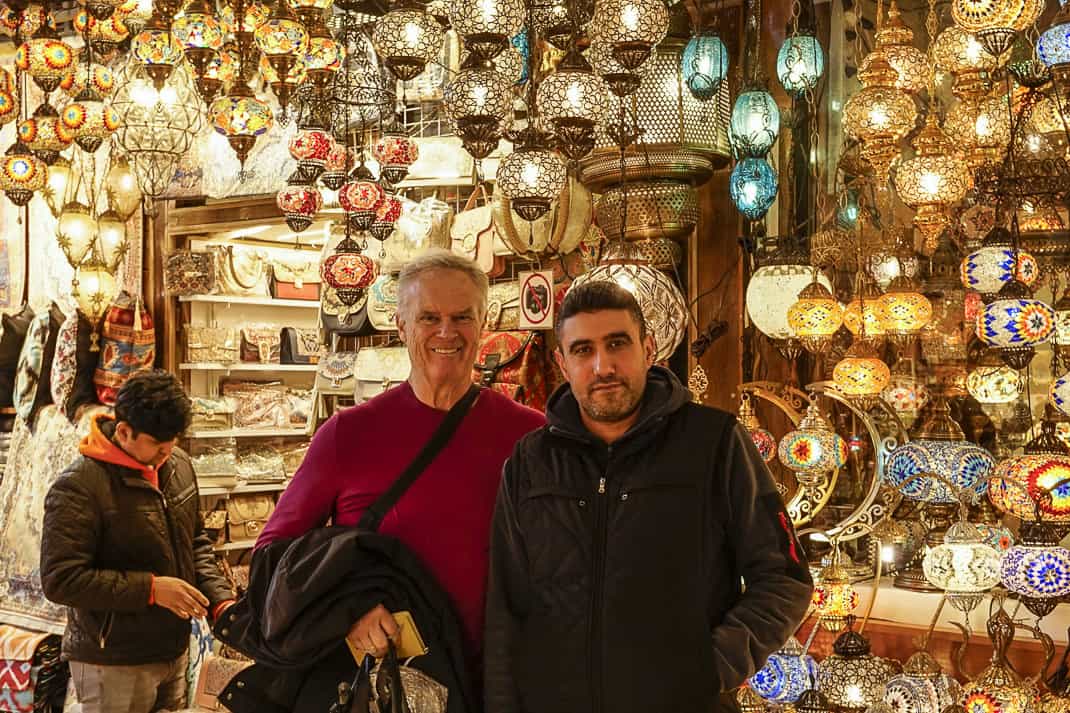
The Grand Bazaar symbolizes Istanbul as much as Aya Sofia, the Blue Mosque and the Bosphorus. Mehmet the Conqueror started it as a warehouse in 1461 and it has grown to 3,000 shops over 61 streets covering 2,470 acres (31 hectares). You could fit 47 St. Peter’s Basilicas inside it.
However, in ‘93 I remembered every jewelry shop had the exact same jewelry: tons of simple gold chains you could buy anywhere. It took me an hour to find something with a Turkish design that said, yes, this is from Turkey and not Des Moines. Last week, the gold shops had anything a mad jeweler could possibly design.
I found a beautiful brass table lamp with a multi-colored mosaic-style lampshade I didn’t think I needed. The shopkeeper, Huseyin, was a tall, well-dressed man in his late 30s who spoke English like a graduate of the Columbia School of Broadcasting.

Erdogan
What hasn’t changed in 30 years is the friendliness of the Turkish people. In ‘93, I traveled by bus from Oludeniz, a backpacker beach town on the southwest coast, up the west coast to Istanbul, stopping in Ephesus, the second most important city in the Roman Empire, and Dikili, a little-known beach town void of tourism. All the Turks I met were kind, hospitable and giving. A busload of Turks even gave me an ovation when I asked the driver a couple questions in Turkish.
Today, they’re still open. They’re just more quiet. They must be. Erdogan has ground down human rights like beans in his morning coffee. Every time I asked about Erdogan, the answer always began with, “Don’t quote me but …”
One restaurant owner said of him, “They don’t teach anything in the universities, to keep people stupid and vote for him.” One woman called Erdogan “a fucking cunt.” I was impressed with her English.
Recap Tayyip Erdogan, 69, was born to a father in the Turkish Coast Guard and a mother who was a housewife. Recap, whose family has Georgian roots, grew up in the poor Istanbul neighborhood of Kasimpasa where he worked as a street vendor selling water and simit, Turkey’s sesame bread rings, to people stuck in traffic. He was a good enough youth soccer player to get an invite from Turkish-league power Fenerbahce, but his dad wouldn’t allow it.
At 22, Recap became interested in conservative politics when he joined the National Turkish Student Union, an anti-communist action group, and soon became head of the Beyoglu neighborhood youth branch of the Islamist National Salvation Party.
He came up through local politics before becoming Istanbul mayor from 1994-98, prime minister from 2003-2014 and then president ever since. His ascent was interrupted by a 10-month prison sentence in 1997 when he recited a pro-Turkish activist’s poem which a judge ruled incited violence and religious hatred.
For 20 years Erdogan has led Turkey away from the secular, open society Attaturk promoted to a more right-wing pro-Islamic culture. He began as a reformist who expanded rights and freedoms. He allowed women to wear the hijab head scarf in offices. He strived to get Turkey in the European Union.
However, he reversed paths. He cracked down on public criticism. He censored the media and passed anti-democratic measures. In 2013, an anti-government protest about plans to cut down trees in Istanbul’s Gezi Park resulted in eight deaths.
A failed coup in 2016 caused 290 deaths, tens of thousands of arrests and the firing of 130,000 government officials. Media and non-government organizations were shut down.
The EU told Turkey to take a hike.

Today it’s worse. Rising deficits, Erdogan’s increasing authoritarianism, Covid and his ill-fated ideas about interest rate policy caused the lira to lose 44 percent of its value in 2021. Inflation this year has topped 80 percent. Five years ago, €1 was worth five lira; today it’s worth 20. The prices in my Istanbul travel guide, published only two years ago, are worthless.
The cost of electricity jumped 57 percent in 2019 and youth unemployment went to 27 percent. In 2018, a worker unable to pay his bills burned himself to death in front of the Parliament building. In 2019, four struggling siblings died in a joint suicide.
A Turkish senior financial official told The Washington Post in June, “I think we’re at the end of our rope.”
Furthermore, Erdogan refused to enforce a second lockdown after a second wave of Covid and he has been heavily criticized for his slow reaction to the Feb. 6 earthquake that hit Southeast Turkey. Media reports more than 45,000 deaths. Locals I talked to with relatives in the area say the true total tops 300,000, many of them Syrian refugees.

This may soon end, however. With his standing in the polls going the same direction he sent the lira, he faces new elections May 14. Istanbul mayor Ekrem Imamoglu, 52, a businessman and social democrat, is considered to have a good chance at winning.
As one restaurant owner told me, “We’re all wanting for it to end.”

Prices
The good news about Turkey’s economic collapse is it’s a pretty cheap country. Meals for two were rarely more than €30. The three-hour Bosphorus cruise was only €20 each. Our centrally located three-star hotel was only €70 a night.
A terrific performance by the Whirling Dervishes was only €34. The Whirling Dervishes are a Turkish cultural tradition that dates back to the 13th century when a mystic poet named Rumi sought to create an Islamic expression of religious life.
We attended a performance at Hodjapasha, a converted 550-year-old hamam (Turkish bath house) not far from the Grand Bazaar. Walking into the tall conical brick structure, it felt like sitting at the bottom of a giant pizza oven.
We sat a couple feet from a round stage where six men in long white billowing tunics and tall, brown stovetop hats stood in a circle. As a five-man orchestra played Islamic prayer music, the half dozen men slowly unfurled the arms to the air and began to spin. With their eyes closed, they tried to reach a trance in which they become closer to god.
Each man took turns observing outside the circle to steady any Dervish who whirls himself into unsteadiness. They spin to various stages of consciousness, ranging from, according to the brochure, “intoxication of the soul” to “the salvation of our country.”
In light of the upcoming election, I wondered that night if they were spinning especially fast.
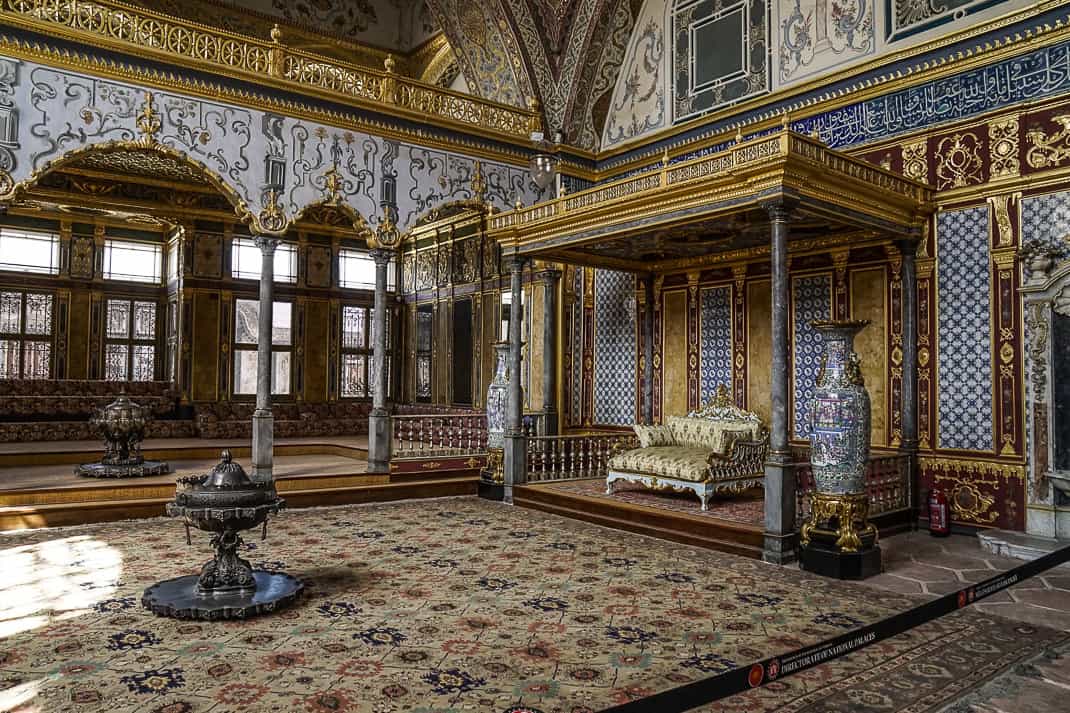
Hamam
The great thing about returning places is you can peel away one layer of the culture and delve further. In ‘93 I hit Istanbul’s must-sees: Aya Sofia, Blue Mosque, Grand Bazaar. On Thursday I did tour the other for the first time. The Ottomans made Topkapi Palace their place of business – and pleasure — for 400 years. Their views of the sea were nearly as remarkable as their meeting rooms and library. Their harem, where up to 500 women worked and reproduced, was as big as our hotel.
But the one must experience I wanted for the first time was a Turkish hamam. These really aren’t originally Turkish. The Romans brought them over when their empire ruled this area. The Byzantines, who liked staying clean, kept them and handed them over to the Ottomans when they rolled through.
They’re still around. In Istanbul they’re as plentiful as Dunkin Donuts in Boston. They’re seemingly on every block. And no, hamams have no happy endings. This is Islam. I kept my amateur standing.
I treated myself and Marina to a hamam on my birthday. Get a nice steam, a sauna, a long massage. Turn into a limp noodle with glowing skin to match. Afterward, I had one question.
What’s the big deal?
I’ve never been into massages. I’d rather give them than receive them. Thus, I wasn’t terribly surprised when the only thing limp was my wallet for being €100 lighter.
I won’t blame the Sarnic Spa & Turkish Bath although we were taken aback when all eight of the workers were from Bali and not Turkey. Our hotel recommended the little place around the corner. It was just a single door down a few steps. We entered a dark corridor where we took turns changing into their throwaway underwear in a shower room no bigger than a closet.
We went into a wet sauna where we sweated alone for about 15 minutes. We proceeded to a massage room where we lay side by side. A pretty, diminutive, young Balinese woman took a mitt and rough scrubbed every inch of my body, peeling off all the dead skin, for about 20 minutes.
She then emptied three big bags of bubbles onto my body and massaged my slippery skin for another 20 minutes. I didn’t feel any more relaxed. I didn’t feel any more clean. I didn’t feel any more aroused.
I felt virtually nothing.
Meanwhile, Marina was nearly moaning in ecstasy.
After 30 years, a hamam was not worth the wait. Istanbul? It sure was. I’d like to come back again.
When Istanbul does.
Part II next Tuesday: Turkish cuisine

If you’re thinking of going …
How to get there: We paid €338 for two round-trip flights on Pegasus Airlines from Rome.
Where to stay: Artefes Hotel, Kucuk Ayasofya Cad, Cayiroglu Sk. No. 17, 90-212-516-5863, www.artefes.com, info@artefes.com. Clean, quiet, simple three-star hotel with very helpful, English-speaking staff a 10-minute walk from the city’s main sites. I paid €289 for four nights.
Where to eat: Antiochia, Asmali Mescit Mah. General Yazgan Sok. 3/C, 90-212-244-0820, 90-532-455-7922, www.antiochiaconcept.com, info@antiochiaconcept.com, noon-midnight Monday-Saturday. Fine dining restaurant specializing in the meats of the southeast Turkey region of Anatolia. I paid €45 for appetizers, main course, dessert and wine.
When to go: July is hot and humid with average highs of 85 and lows of 69. January is the coldest at 48-37. Last week it was 60-40 with rain three of the four days.
For more information: Ministry of Culture & Tourism. Offices at Istanbul Airport, Sabiha Gokcen Airport, Sirkeci Train Station and the Hippodrome in Sultanahmet, 90-212-511-5888, 9:30 a.m.-6 p.m. mid April-September, 9 a.m.-5:30 p.m. October-mid April.


April 4, 2023 @ 4:58 pm
Love your irreverent writing style
April 10, 2023 @ 6:06 pm
Thanks, Daniel. I try.
April 4, 2023 @ 5:34 pm
Another GREAT article John. I was in Istanbul in 1979….and the Bazaar was just as you described. We hired a young child to help us find our way out. It has changed…ALOT! Great pictures as well. Thanks for keeping us sometime “armchair” travelers in the know!
April 10, 2023 @ 6:06 pm
In ’79 Istanbul would’ve been wilder. Wish I was there then. I’m blogging about The Pudding Shop in Part IV and the atmosphere in Istanbul in the ’60s and ’70s.
April 5, 2023 @ 3:30 pm
Thanks for the memories. I was there in the early 90’s also.
April 10, 2023 @ 6:05 pm
Thanks, Alice. Make it to The Pudding Shop?